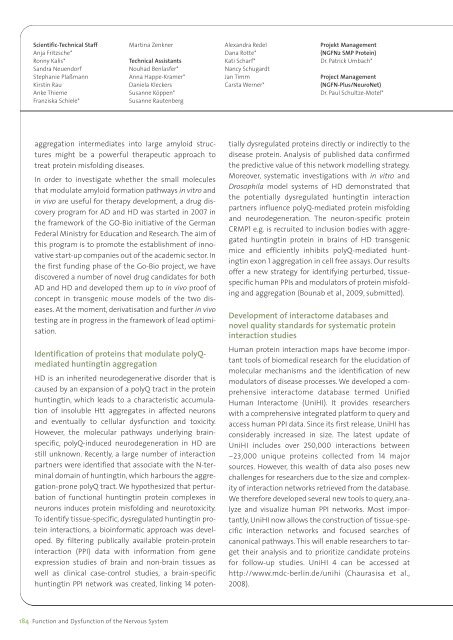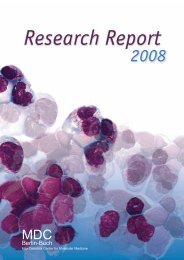You also want an ePaper? Increase the reach of your titles
YUMPU automatically turns print PDFs into web optimized ePapers that Google loves.
Scientific-Technical Staff<br />
Anja Fritzsche*<br />
Ronny Kalis*<br />
Sandra Neuendorf<br />
Stephanie Plaßmann<br />
Kirstin Rau<br />
Anke Thieme<br />
Franziska Schiele*<br />
Martina Zenkner<br />
Technical Assistants<br />
Nouhad Benlasfer*<br />
Anna Happe-Kramer*<br />
Daniela Kleckers<br />
Susanne Köppen*<br />
Susanne Rautenberg<br />
aggregation intermediates into large amyloid structures<br />
might be a powerful therapeutic approach to<br />
treat protein misfolding diseases.<br />
In order to investigate whether the small molecules<br />
that modulate amyloid formation pathways in vitro and<br />
in vivo are useful for therapy development, a drug discovery<br />
program for AD and HD was started in 2007 in<br />
the framework of the GO-Bio initiative of the German<br />
Federal Ministry for Education and <strong>Research</strong>. The aim of<br />
this program is to promote the establishment of innovative<br />
start-up companies out of the academic sector. In<br />
the first funding phase of the Go-Bio project, we have<br />
discovered a number of novel drug candidates for both<br />
AD and HD and developed them up to in vivo proof of<br />
concept in transgenic mouse models of the two diseases.<br />
At the moment, derivatisation and further in vivo<br />
testing are in progress in the framework of lead optimisation.<br />
Identification of proteins that modulate polyQmediated<br />
huntingtin aggregation<br />
HD is an inherited neurodegenerative disorder that is<br />
caused by an expansion of a polyQ tract in the protein<br />
huntingtin, which leads to a characteristic accumulation<br />
of insoluble Htt aggregates in affected neurons<br />
and eventually to cellular dysfunction and toxicity.<br />
However, the molecular pathways underlying brainspecific,<br />
polyQ-induced neurodegeneration in HD are<br />
still unknown. Recently, a large number of interaction<br />
partners were identified that associate with the N-terminal<br />
domain of huntingtin, which harbours the aggregation-prone<br />
polyQ tract. We hypothesized that perturbation<br />
of functional huntingtin protein complexes in<br />
neurons induces protein misfolding and neurotoxicity.<br />
To identify tissue-specific, dysregulated huntingtin protein<br />
interactions, a bioinformatic approach was developed.<br />
By filtering publically available protein-protein<br />
interaction (PPI) data with information from gene<br />
expression studies of brain and non-brain tissues as<br />
well as clinical case-control studies, a brain-specific<br />
huntingtin PPI network was created, linking 14 poten-<br />
184 Function and Dysfunction of the Nervous System<br />
Alexandra Redel<br />
Dana Rotte*<br />
Kati Scharf*<br />
Nancy Schugardt<br />
Jan Timm<br />
Carsta Werner*<br />
Projekt Management<br />
(NGFN2 SMP Protein)<br />
Dr. Patrick Umbach*<br />
Project Management<br />
(NGFN-Plus/NeuroNet)<br />
Dr. Paul Schultze-Motel*<br />
tially dysregulated proteins directly or indirectly to the<br />
disease protein. Analysis of published data confirmed<br />
the predictive value of this network modelling strategy.<br />
Moreover, systematic investigations with in vitro and<br />
Drosophila model systems of HD demonstrated that<br />
the potentially dysregulated huntingtin interaction<br />
partners influence polyQ-mediated protein misfolding<br />
and neurodegeneration. The neuron-specific protein<br />
CRMP1 e.g. is recruited to inclusion bodies with aggregated<br />
huntingtin protein in brains of HD transgenic<br />
mice and efficiently inhibits polyQ-mediated huntingtin<br />
exon 1 aggregation in cell free assays. Our results<br />
offer a new strategy for identifying perturbed, tissuespecific<br />
human PPIs and modulators of protein misfolding<br />
and aggregation (Bounab et al., 2009, submitted).<br />
Development of interactome databases and<br />
novel quality standards for systematic protein<br />
interaction studies<br />
Human protein interaction maps have become important<br />
tools of biomedical research for the elucidation of<br />
molecular mechanisms and the identification of new<br />
modulators of disease processes. We developed a comprehensive<br />
interactome database termed Unified<br />
Human Interactome (UniHI). It provides researchers<br />
with a comprehensive integrated platform to query and<br />
access human PPI data. Since its first release, UniHI has<br />
considerably increased in size. The latest update of<br />
UniHI includes over 250,000 interactions between<br />
~23,000 unique proteins collected from 14 major<br />
sources. However, this wealth of data also poses new<br />
challenges for researchers due to the size and complexity<br />
of interaction networks retrieved from the database.<br />
We therefore developed several new tools to query, analyze<br />
and visualize human PPI networks. Most importantly,<br />
UniHI now allows the construction of tissue-specific<br />
interaction networks and focused searches of<br />
canonical pathways. This will enable researchers to target<br />
their analysis and to prioritize candidate proteins<br />
for follow-up studies. UniHI 4 can be accessed at<br />
http://www.mdc-berlin.de/unihi (Chaurasisa et al.,<br />
2008).

















